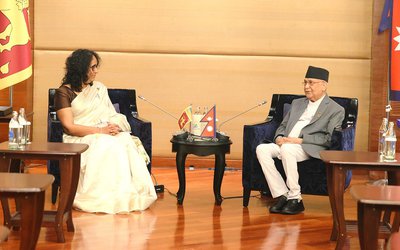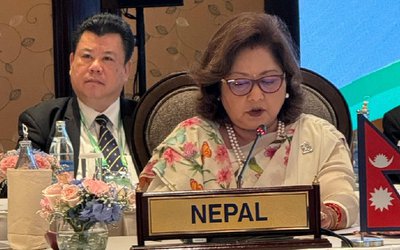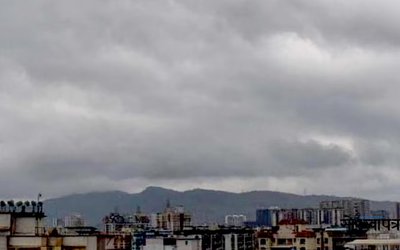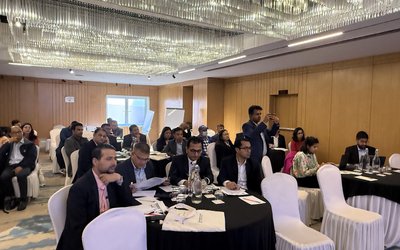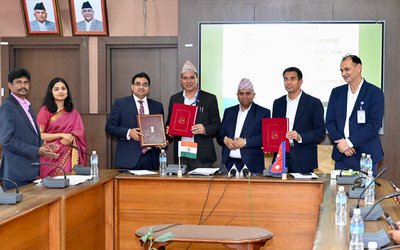
Despite the installment of early warning system, the massive floods caused by record high torrential rains washed out houses, paddy fields, roads and irrigation canals, killing over 200 people and damaging property worth over billions of rupees. As flooding and landslides are almost a regular phenomenon, the time has come for the government to improve early warning system by upgrading its weather and flood forecasting
For Khushi Lal Chaudhary, 62, a resident of Rajapur, it was like a nightmare. Never in his life, he saw Babai and Bheri crossing such limits. “I don’t understand where such a massive tide came from and where it vanished? It was much bigger than the Karnali,” said Chaudhary.
Although Kushi Lal’s 8-member family remained safe and intact, he saw floods inundating his house and affecting his cattle and paddy. “ We survived because we ran to the roads and stayed overnight there,” said Chaudhary.
Like Khusi Lal, the people living in the villages have similar stories to tell. Though there was a heavy rain throughout the day on August 14, the villagers did not imagine that there was such a massive rainfall upstream of the rivers.
“There was water everywhere and it was difficult to distinguish river and road. The whole district was cut off from the rest of the country by road as the floods washed away a portion of the East-West highway,” said Tej Prasad Paudyal, Chief District Officer of Bardiya. “There was a havoc in the areas near Babai and Karnali when rivers started overflowing.”
Although the early warning system was activated, the level of water was record high and the system failed to completely save the lives. Installed with the support from Practical Action, Early Warning System worked but it failed to gauge the level of water.
According to Department of Meteorology and Hydrology, the floods even washed out the gauging station. Although people were informed about the possible scenario, lives of hundreds of people were saved but the people also died because there was a record breaking flooding.
According to flood forecasting division of Department of Hydrology and Meteorology, on August 15, water level at Karnali river was 10094.76 cusec meter at Chisapani. The discharge level was 7333.76 and 5908.517 respectively on August 16 and 17.
Similarly, the water levels of West Rapti and Kusum were 6199.708, 1209.192 and 270.15 on August 15,16 and 17. Similarly, the water level at Narayan river was 9871.375, 7026.121 and 3707.041 on August 15,16 and 17.
The torrential rains have been affecting Nepal since 14 August 2014, causing massive floods and several landslides in 19 districts throughout the country. The Department of Hydrology and Meteorology records show water level in Koshi, Narayani, Karnali and west Rapti rivers increased above warning level during 14-16 August. In Babai River in Bardiya, where the early warning system (EWS) was built on the existing gauge station, the station has been washed away by flood and no EWS worked which resulted in human deaths in addition to huge property loss.
The water overflowing the banks of these rivers caused inundation in most of the village development committees (VDCs) of Siraha, Dang, Surkhet, Banke, Bardiya and Kailali districts. Of the 19 districts affected by the floods, five districts (Jajarkot, Salyan, Rukum, Rolpa and Lalitpur) have also experienced landslides.
According to initial reports, a total of 43,354 families (216, 770 people) have been affected, of which 13,486 families (67,430 people) are displaced. Some 105 people died and 153 went missing; and 53 people have been injured.
The floods and landslides have damaged infrastructure such as roads connecting district headquarters to the affected VDCs; bridges; culverts; local markets; transport vehicles as well as livestock; crops and daily consumables. Highways, linking Banke to Bardiya, Nepalgunj to Surkhet and Surkhet to neighboring districts, have been blocked due to landslides and floods. The floods have swept away five suspension bridges in Surkhet, affecting the daily movement for those hit by the floods.
According to the Ministry of Home Affairs, a total of 11,044 houses have been fully destroyed and 11,037 houses partially damaged in the affected districts. The communication network and electricity supply are greatly restricted due to fallen electrical and telecommunication poles. Drinking water supply systems have been disrupted in Surkhet valley while hand pumps have been contaminated in the southern plains due to water inundation. According to the Home Ministry, 269 people have died so far while 86 people have been injured, 927 are missing, and over 2,500 families have been displaced.
The same areas where people earlier feared drought due to the delayed onset of monsoon are now either submerged in water or swept away. The worst hit areas were in western Nepal where the flood swept away homes made of mud, bamboo, and straw, leaving many homeless. Some 75% of the displaced population is from the districts of Surkhet, Bardiya, and Kailali.
Following the disaster, the Nepal Red Cross Society (NRCS) district chapters immediately deployed their trained volunteers to conduct rapid assessments and provide relief services to the affected people. However, their access to the affected areas has been restricted due to the inundation of entire villages and blocked roads. Also, volunteers have been facing problems in identifying and managing the temporary evacuation centers due to low availability of public places and safe places in comparison to the large number of displaced people.
Along with the volunteers, Nepal army, armed police force and Nepal police evacuated affected families from high risk areas to shelters in the schools and public places. Some families are still living in open places.
Although the rain has gradually decreased from the evening of 16 August and flood waters receded, the destruction of flood is beyond the recognition of people.
This is the second major disaster related to the ongoing monsoon season. In early August, massive landslides from the hillside in Jure, Mankhaa VDC of Sindhupalchowk district in Nepal, killed 33 people with 123 people missing. They were all declared dead by the government of Nepal.
The floods have inundated a large number of houses in district headquarters Gulariya and many VDCs in the district. In Dang, the number of dead from floods has reached 15, according to District Police Office, Dang.
Continual Process
Although the flood recedes now, flooding will happen again sooner rather than later. The floods that have killed more than 200 people in Nepal are precisely what climate scientists have warned of. Urgent action is needed to protect the area's vulnerable people. It is not unusual to have flash floods. A 2013 study of the Himalayas' history shows floods have been common for at least 1000 years.
"The early warning system is noy designed for such extreme events. These floods have taught us a lesion that we need to improve our system,” said Gehendra Gurung, Head of disaster and Climate Change division, Practical Action Nepal.
Scientists are saying that the interval between two extreme events is now shortening. The Himalayas are projected to receive more monsoon rain as the climate warms. Combined with extra glacier melt, flooding will worsen. Just a year ago, Nepal suffered severe floods. Despite several attempts to increase preparedness, little has been achieved.
One of the reasons behind the damage is the poor monitoring mechanisms, and there needs to be better communication systems that can warn communities of coming floods.
In Sunkosi, on 6 Aug, rescuers called off the search operation and said 156 people were presumed killed; 34 bodies had been recovered (AFP, 6 Aug 2014). As of 18 Aug, the Sunkoshi River was still blocked. Progress on releasing water from the naturally created dam remained slow, with additional rainfall increasing the threat of flash floods further downstream. 476 people remain displaced and early recovery solutions are urgently needed.
It has also been suggested that changing trade-winds in the wake of climate change will only bring even more precipitation during wet seasons to some areas, while others will be struck with uncharacteristic droughts.
GDP Losses
A New Asian Development Bank ‘s Climate and economic report for South Asia revealed that climate change-driven events like melting glaciers pose a grave risk to Nepal’s economy, and could cause losses equal to almost 10% of the country’s annual gross domestic product (GDP) by 2100.
“The population is extremely vulnerable, not only to the immediate threats of increasingly frequent glacial lake overflows, landslides, flash floods, and droughts, but also to longer-term climate change, which will ultimately reduce water availability and limit crop productivity,” said Bindu Lohani, ADB Vice-President for Knowledge Management and Sustainable Development.
The report, titled Assessing the Costs of Climate Change and Adaptation in South Asia, predicts the six countries—Bangladesh, Bhutan, India, Maldives, Nepal, and Sri Lanka—will see an average economic loss of 1.8% of their collective GDP every year by 2050, rising sharply to 8.8% in 2100.
Without changes to current global behavior, Nepal would see economic losses equivalent to up to 2.2% of annual GDP by 2050, widening to 9.9% by the end of the century. But if mitigation and adaptation steps are taken, the damage could be limited to around 2.4% of GDP by 2100.
Nepal’s agriculture sector, which employs two thirds of the labor force, will reap some short-term gains from warmer temperatures and melting snow and ice, which boosts water supplies. But over time, glacial retreat and uncertainty about the summer monsoon’s start and end dates will reduce crop yields and cause food insecurity.
Melting glaciers, which form high-altitude lakes that can suddenly breach and cause catastrophic flooding downstream, also pose a risk to both human settlements and hydropower systems. In mountainous areas, landslides are likely to increase, threatening lives and infrastructure.
Deteriorating and dwindling forests will result in habitat losses for some of the country’s rich flora and fauna, including snow leopards, undermining the country’s appeal for eco-tourists.
The report does not provide detailed adaptation cost projections on a country basis, although in the energy sector it notes that a rising gap between demand and supply could see Nepal face an annual adaptation bill of over $118 million in the 2030s, rising by another $100 million in the 2050s.
The report also details adaptive measures that countries should consider in responding to climate threats, including the use of drought-, flood- and saline-resistant crop varieties, more integrated coastal zone management, increased efficiencies in the energy sector, improved disease and vector surveillance, more protection of groundwater resources and greater use of recycled water.
Caritas Nepal is responding to massive flooding in Nepal, where continuous rainfall last week wiped out homes, roads and crops and sent people fleeing from their homes.
The government has evacuated thousands of people to safer locations, but the evacuees “don’t have cooked food or basic items like blankets and mattresses,” says Arpana Karki, Program Coordinator for Caritas Nepal’s Disaster Management Department.
Though travel is difficult due to washed-away roads, various organizations including the army and police are mobilised to aid families in districts like Banke, Bardiya, Surkhet and Dang.
Land erosion, siltation and land degradation are happening due to the flooding. As the land is completely covered by sand, people can grow crops just in winter. They will have to wait another 4 to 5 months for their harvest.

Keshab Poudel
Poudel is the editor of New Spotlight Magazine.
- FM Dr. Deuba’s India Visit: Mission Aborted
- Mar 26, 2025
- AMBASSADOR MAEDA TORU: Warm Regards
- Mar 24, 2025
- PRO-MONARCHY MOVEMENT: Rising Dissatisfaction
- Mar 23, 2025
- Dr. PRABIN MANANDHAR: Person With Humility
- Mar 16, 2025
- US SUSPESION OF GRANT: Impact On Nepal
- Mar 10, 2025

